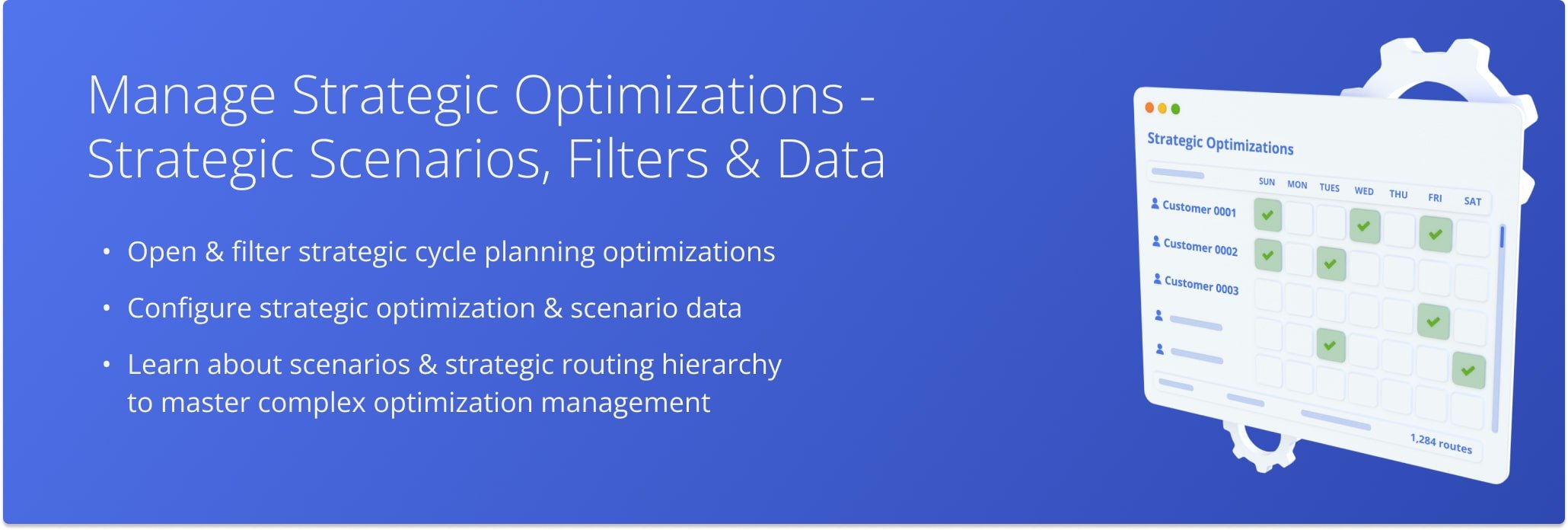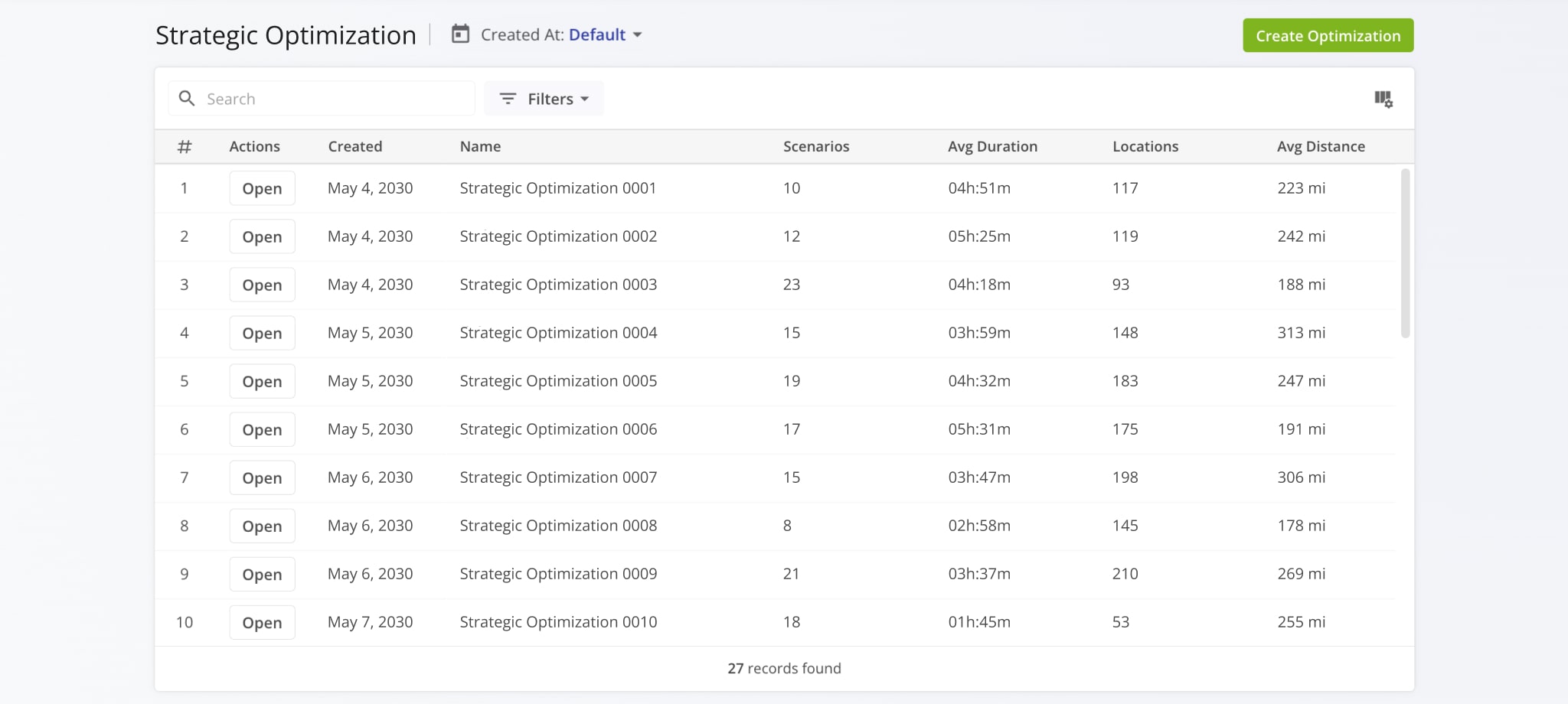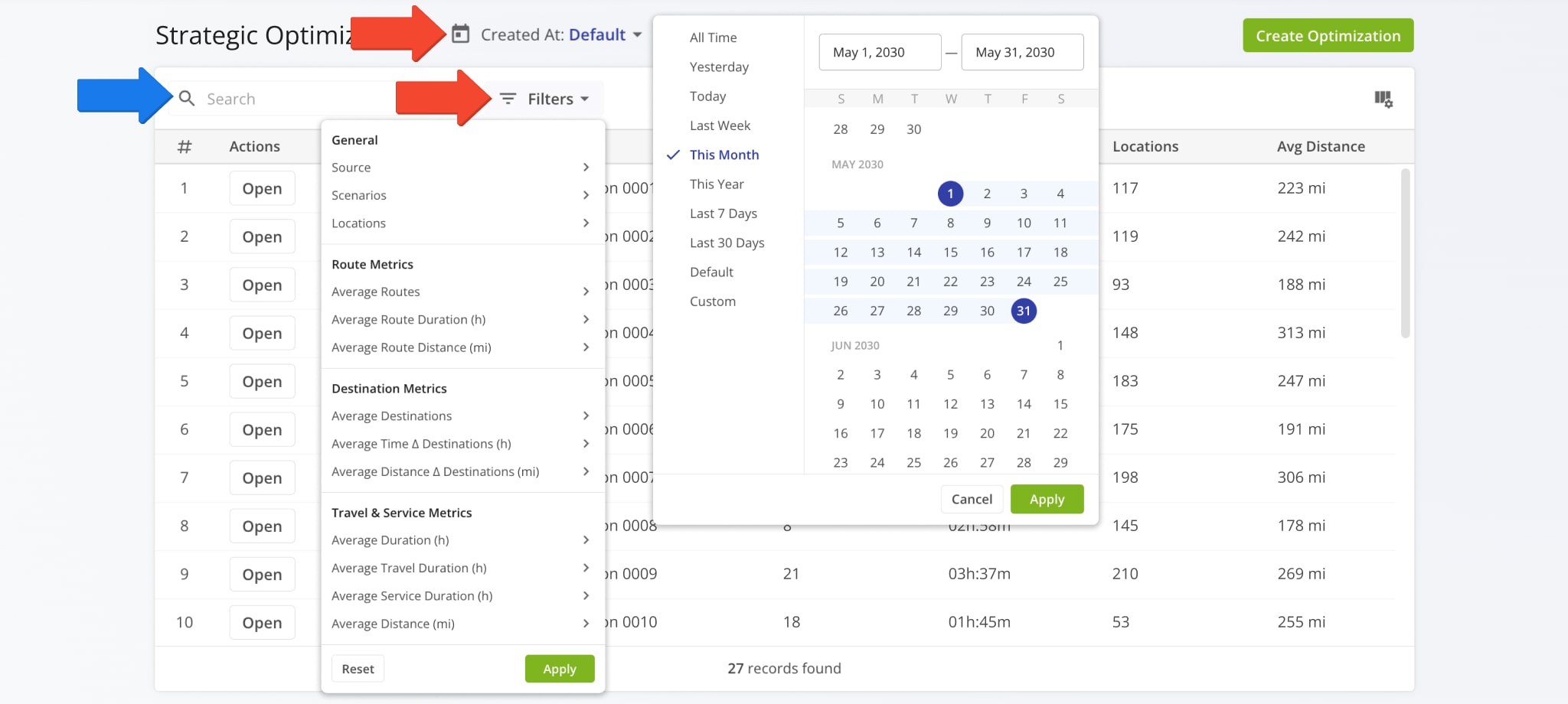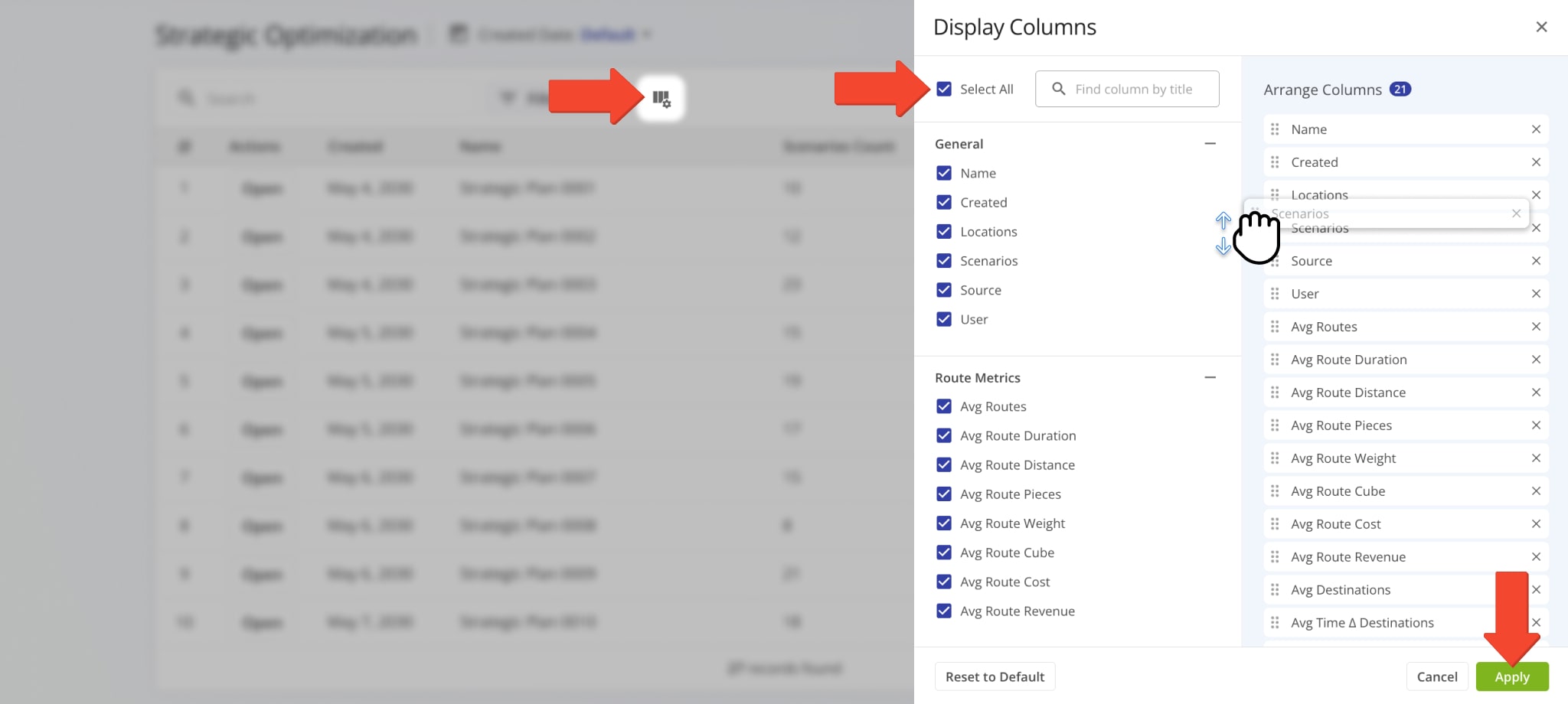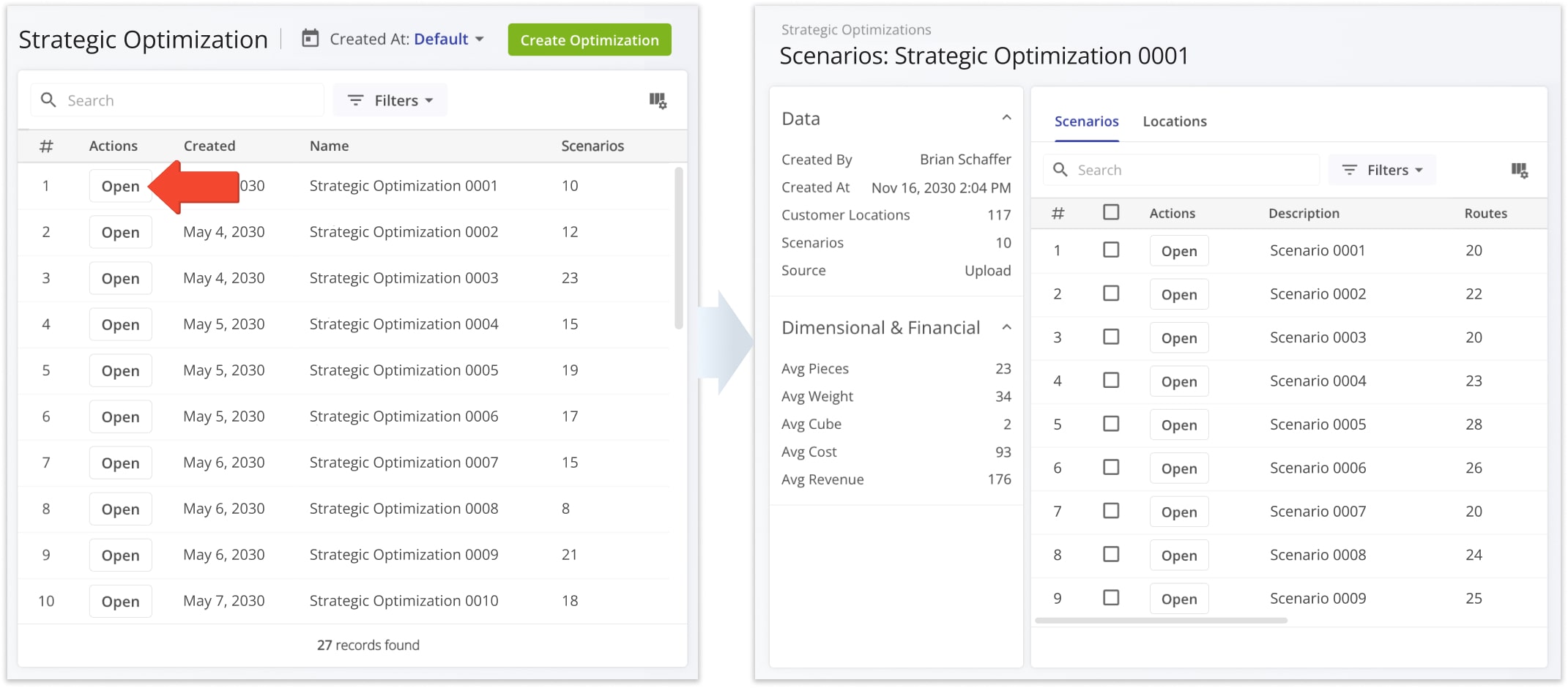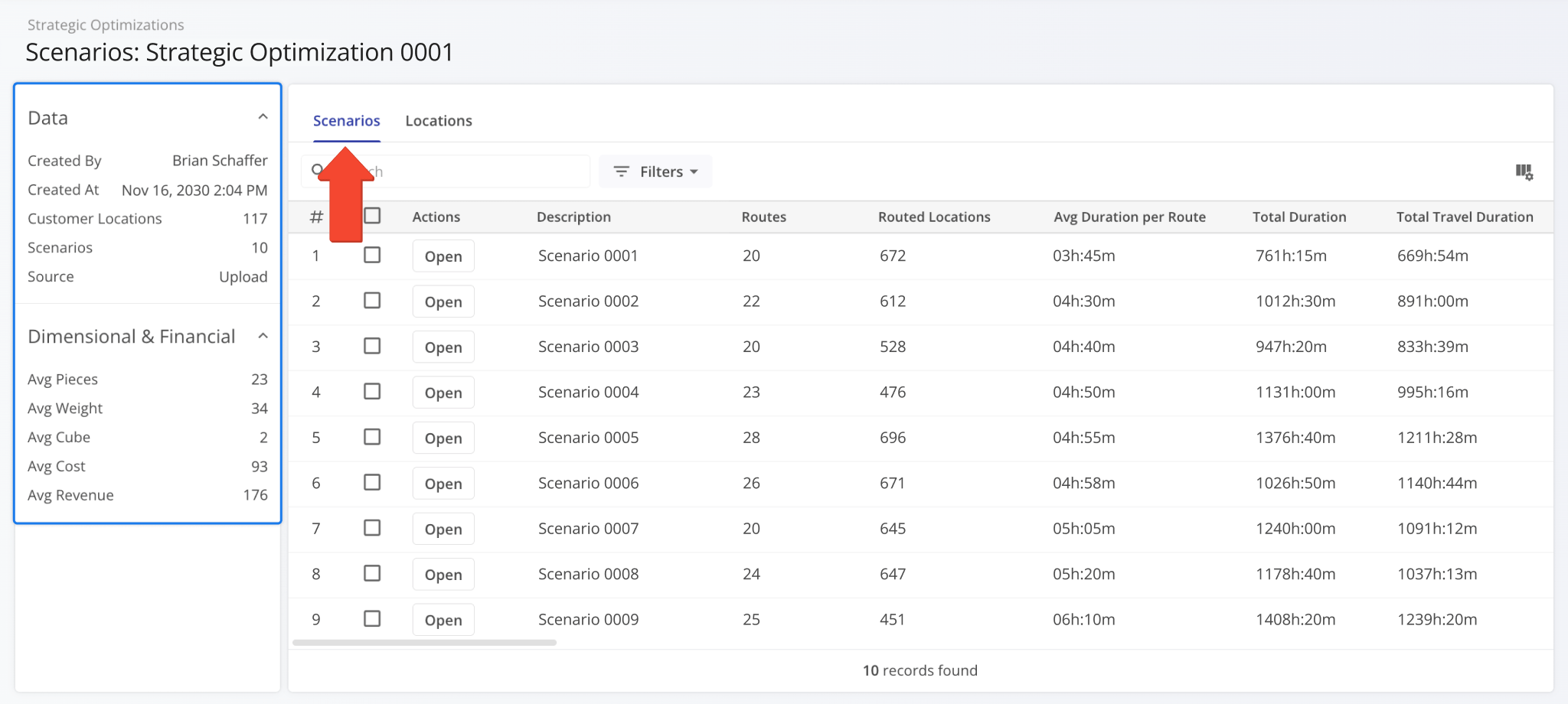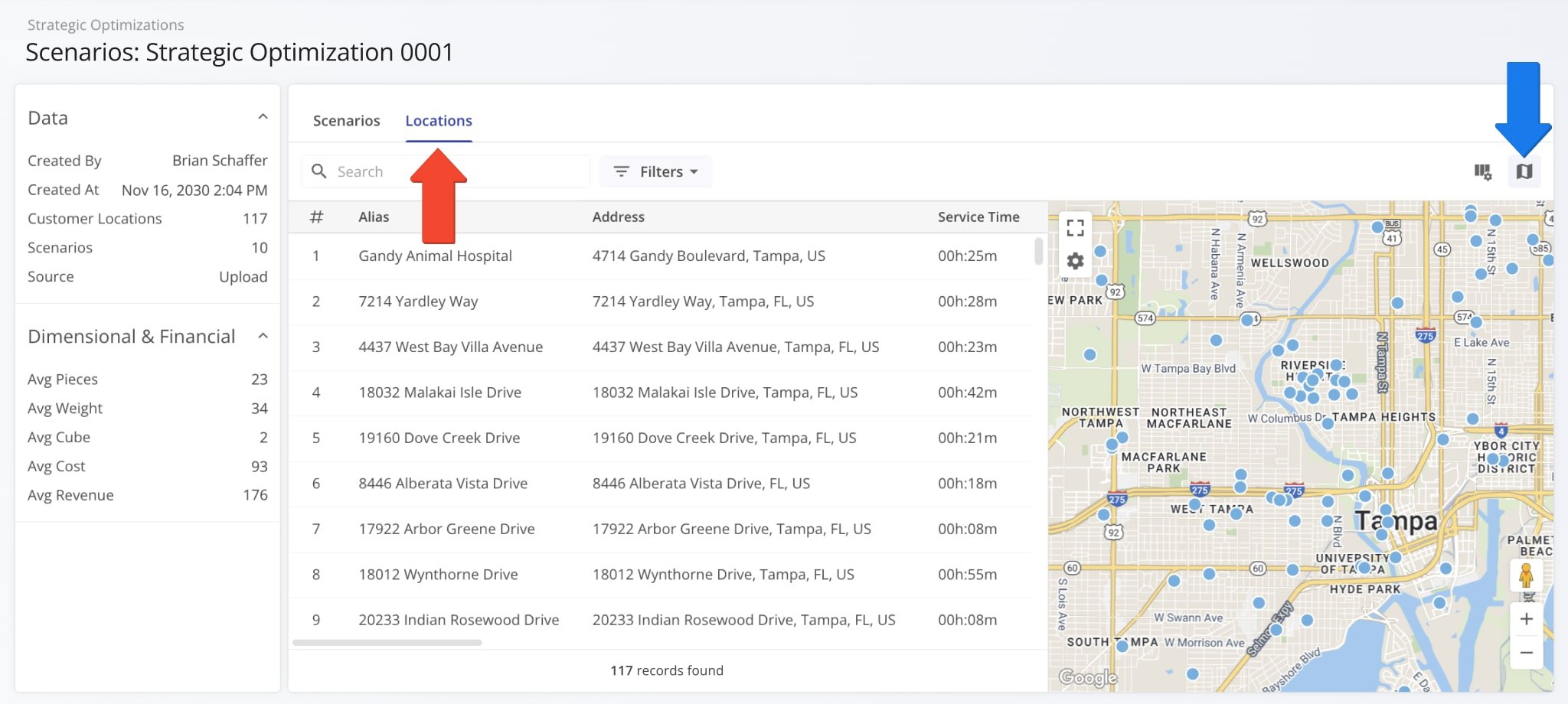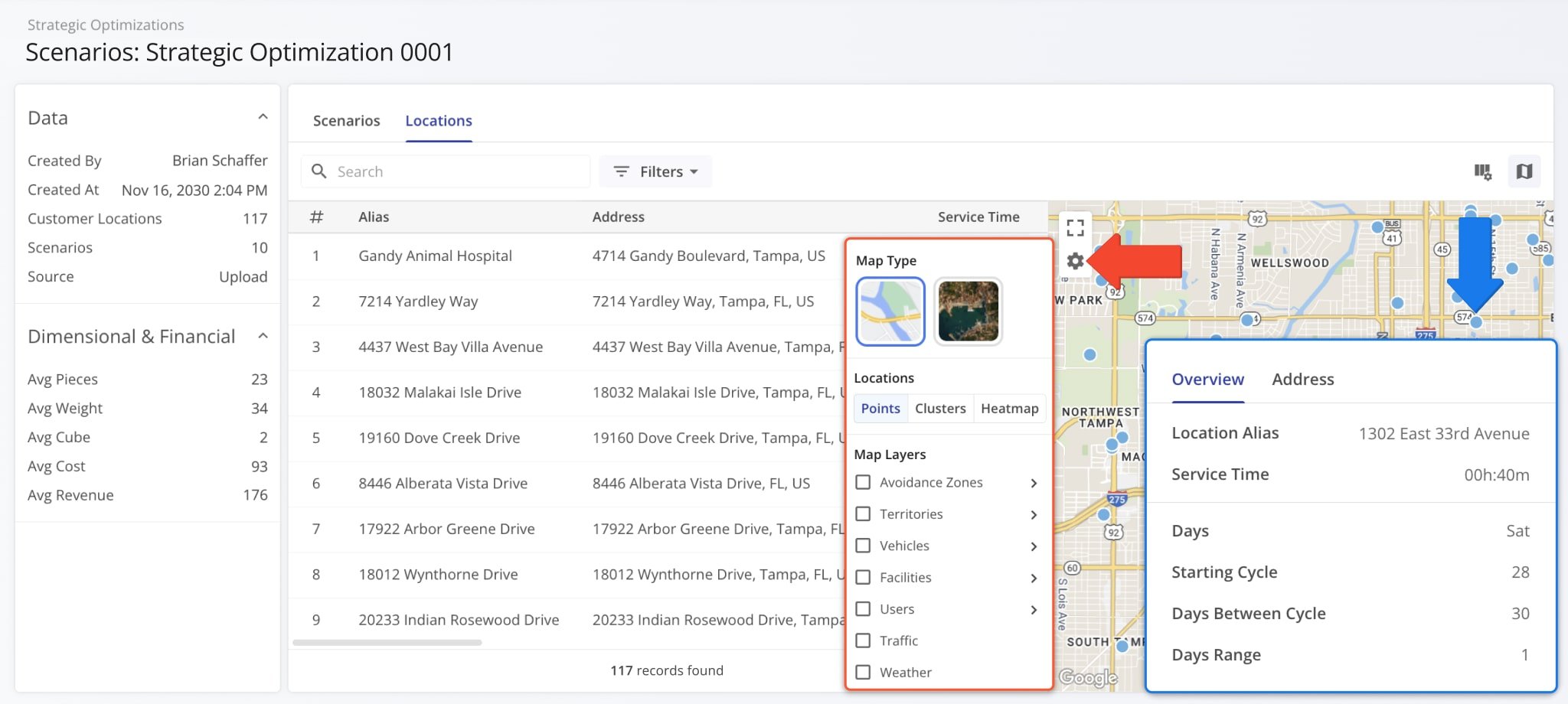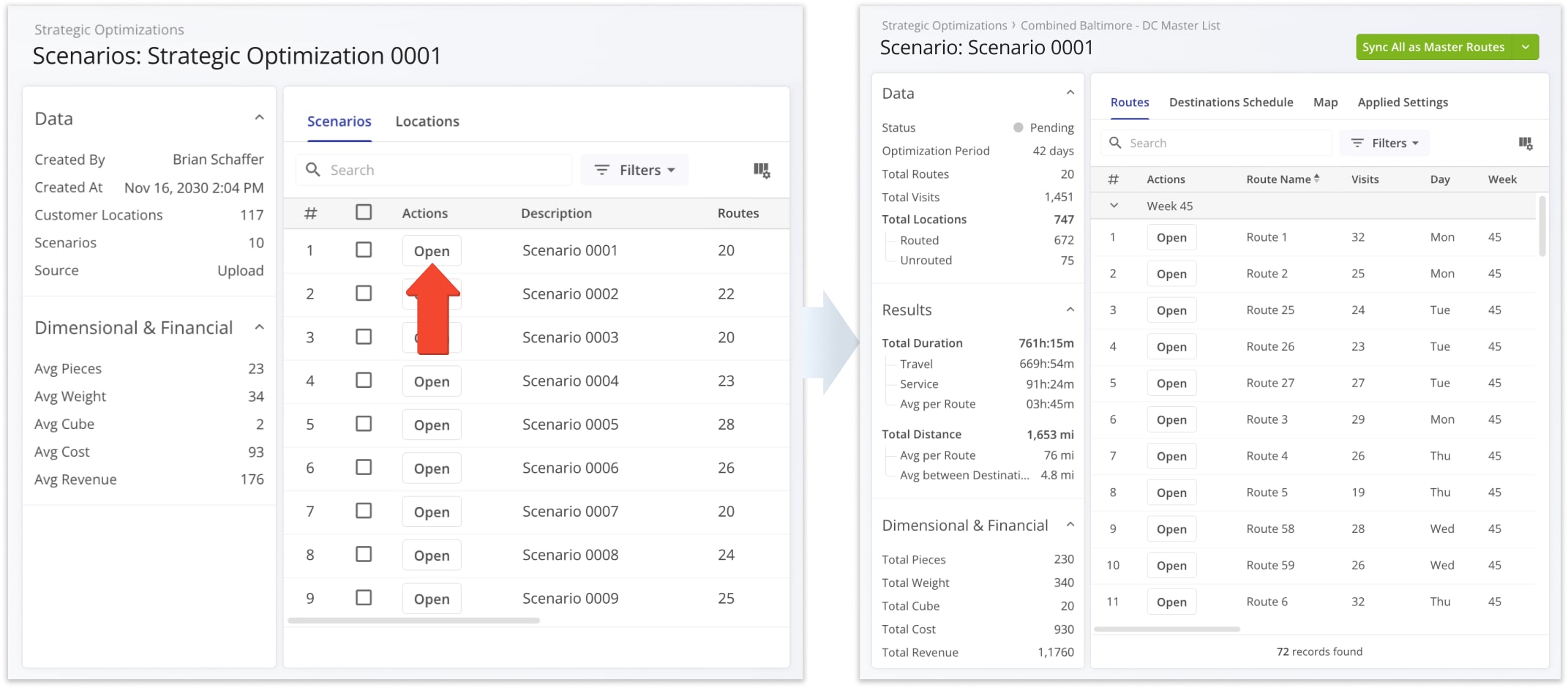Manage Strategic Optimizations – Automated Strategic Cycle Planning With Recurring Routing
Route4Me’s Strategic Optimizations simplify complex strategic cycle planning for multi-frequency delivery and service schedules over extended planning periods. Sync data via SFTP, upload Customer addresses with schedules, and create recurring route plans for thousands of routes with weekly, bi-weekly, or other visit requirements with one click.
All you have to do is upload your data, and Route4Me’s enterprise route optimization API will handle the rest according to your recurring schedules. In this guide, you’ll learn how to open, filter, and manage your Optimizations.
NOTE: “Cycle” in Recurring Routing with Strategic Optimizations refers to an instance when a specific Recurring Schedule repeats.
Table of Contents
Strategic Optimizations And Scenarios With Recurring Route Schedules
When you create Strategic Optimizations, Route4Me will automatically generate the most efficient recurring route cycles and Scenarios according to your settings. You can find them in your account’s Strategic Optimizations.
Go to “Strategic Routing” > “Scenarios” from the Navigation Menu to manage Strategic Optimizations and their Scenarios.
Open Your Strategic Optimizations
Filter Strategic Optimizations By Created Date And Optimization Data
To find a specific Strategic Optimization on your account, you can use custom filters or search by name with the “Search” field. Click the “Created At” button to open the calendar and filter Optimizations by their creation date or time frame. Then, you can further refine the shown list by clicking the “Filters” button.
You can see a list of Strategic Optimization Filters in the image below and find more information about those data values and attributes in the following section of this guide.
Customize Strategic Optimizations Data Table
To customize the columns on your Strategic Optimizations page, click the Display Columns Button. Then, check the boxes next to columns you want to enable. You can change their positions by dragging column names. Click “Apply” to save your changes.
These data items also correspond to filter options. See the table below for more details on the available data values.
| Column | Description | |
|---|---|---|
| General | ||
| Name | Unique name or alias of the optimization. You can use names to find it via the “Search” field. | |
| Created | Date when the strategic optimization was created via SFTP data sync. | |
| Locations | Total number of locations included in the optimization scenarios and routes. | |
| Scenarios | Total number of scenarios included in the strategic optimization. | |
| Source | How the strategic optimization was created. Currently supports SFTP. | |
| User | User who uploaded the strategic optimization. | |
| Route Metrics | ||
| Avg Routes | Average number of routes per week. | |
| Avg Route Distance | Average distance of routes in the Strategic Optimization. | |
| Avg Route Duration | Average duration of routes in the Strategic Optimization. | |
| Avg Route Pieces | Average Pieces value (number of units) of Orders on routes in the Strategic Optimization. | |
| Avg Route Weight | Average Weight value of Orders on routes in the Strategic Optimization. | |
| Avg Route Cube | Average Cube (volume) value of Orders on routes in the Strategic Optimization. | |
| Avg Route Cost | Average cost associated with routes in the Strategic Optimization. | |
| Avg Route Revenue | Average revenue generated by routes in the Strategic Optimization. | |
| Destination Metrics | ||
| Avg Destinations | Average number of destinations on routes included in the strategic optimization. | |
| Avg Time Delta Destinations | Average time between destinations on routes included in the strategic optimization. | |
| Avg Travel Delta Destinations | Average distance between destinations on routes included in the strategic optimization. | |
| Travel & Service Metrics | ||
| Avg Duration | Average duration of routes included in the strategic optimization. Combination of Travel Duration and Service Duration. | |
| Avg Travel Duration | Average Travel Time Duration of routes included in the strategic optimization. | |
| Avg Service Duration | Average Service Time Duration of routes included in the strategic optimization. | |
| Avg Distance | Average distance of routes included in the strategic optimization. | |
Open Scenarios And Customer Locations From Strategic Optimizations
Strategic Optimizations provide an overview of your Recurring Routing Scenarios bundled into Optimizations. To view more detailed data about a specific Optimization and its associated Scenarios, click the “Open” button next to it.
After that, you can see the Scenarios included in the Strategic Optimization you opened and their associated data such as the number of routes, visits, average and total route durations, etc.
On the left, you can find a summary panel that shows the Strategic Optimization’s main data and associated business rules.
Click the “Locations” tab to see the Locations associated with the Strategic Optimization and its Scenarios. Additionally, this is where you can find data relating to the visit frequency and pattern of each Location.
You can also click the Map Icon in the top-right to open the dynamic Locations Map.
On the Locations Map, you can hover over a Location to view its address and scheduling details in the Strategic Optimization.
Click the Gear Icon on the Locations Map to open the Map Settings. See the table below for more details.
| Map Settings | Description | |
|---|---|---|
| Map Type | ||
| Locations | Switch between dispalying Locations as “Points” (individual map markers), “Clusters” (grouped map markers based on proximity), and “Heatmap” (Location density overlay). | |
| Avoidance Zones | Enable an overlay showing your Avoidance Zone areas on the map. | |
| Territories | Enable an overlay showing your Territory areas on the map. | |
| Vehicles | Enable Vehicle location indicators on the map. | |
| Facilities | Enable Facility location indicators on the map. | |
| Users | Enable User location indicators on the map. NOTE: User tracking is active for Users on routes and shows their last synced location if no route is currently active for a User. | |
| Traffic | Enable a live traffic overlay on the map. | |
| Weather | Enable a live weather overlay on the map. | |
Filter Strategic Scenarios And Customer Locations
To find specific Scenarios or Locations in the Strategic Optimization, you can use custom filters or search by name or attribute with the “Search” field. Click the “Filters” button to refine the data shown on this page.
The “Scenarios” and “Locations” tab support different filters based on their associated data values and scheduling details. Find more information about those data values and attributes in the following section of this guide.
Customize Scenario Data Columns And Settings
Just like Optimizations, you can customize the data shown for your Scenarios and Locations. To do so, click the Display Columns Button and check the boxes next to the columns you wish to enable. You can change their positions by dragging column names on the right. Click “Apply” to save your data column settings.
The “Scenarios” and “Locations” tabs support different data columns. These data items also correspond to filter options. See the table below for more details.
| Column | Description | |
|---|---|---|
| Scenarios | ||
| Overview | ||
| Description | Functions as the alias of a scenario and includes schedule details and parameters. | |
| Status | Current status of the Scenario. Learn more about Strategic Scenario Management. | |
| Optimization Period | The period of time across which scenario routes will be scheduled. | |
| Route & Destination Metrics | ||
| Routes | Number of routes included in the scenario. | |
| Total Visits | Number of visits to be planned for routes in the scenario | |
| Routed Locations | Number of Locations included in Scenario Routes. | |
| Routed Locations (%) | Percentage of all Locations included in Scenario Routes. | |
| Unrouted Locations | Number of Locations not included in Scenario Routes. | |
| Unrouted Locations (%) | Percentage of all Locations not included in Scenario Routes. | |
| Created Routes | Total number of scenario routes that have been successfully created. | |
| Ad Hoc Created Routes | Total number of planned routes imported as ad-hoc routes. | |
| Master Created Routes | Total number of planned routes imported as Master Routes for Recurring Routing. | |
| Failed Routes | Number of routes that couldn’t be optimized based on constraints and optimization settings. | |
| Accepted | Date on which the scenario was accepted. | |
| Created Routes (%) | Percentage of scenario routes that have been successfully created. | |
| Ad Hoc Created Routes (%) | Percentage of planned routes imported as ad-hoc routes. | |
| Master Created Routes (%) | Total number of planned routes imported as Master Routes for Recurring Routing. | |
| Failed Routes (%) | Routes that couldn’t be optimized based on constraints and optimization settings as a percentage of total planned routes. | |
| Duration Metrics | ||
| Avg Duration per Route | Average duration of routes in the scenario. | |
| Total Duration | Total duration of routes in the scenario. | |
| Total Travel Duration | Total combined duration of scenario route travel time. | |
| Total Service Duration | Total duration of route Service Time in the scenario. | |
| Avg Time Δ Destinations | Average travel time between scenario route destinations. | |
| Total Travel Duration % | Percentage of total route duration spent as Travel Time. | |
| Total Service Duration % | Percentage of total route duration spent as Service Time. | |
| Distance Metrics | ||
| Avg Distance per Route | Average travel distance of routes in the scenario. | |
| Total Distance | Total combined distance of scenario routes. | |
| Avg Distance Δ Destinations | Average travel distance between scenario route destinations. | |
| Dimensional & Financial | ||
| Total Pieces | Total number of Pieces (units) of Orders included in Scenario Routes. | |
| Total Weight | Total Weight value of Orders included in Scenario Routes. | |
| Total Cube | Total Cube value (physical volume) of Orders included in Scenario Routes. | |
| Total Cost | Total Cost value associated with in Scenario Routes. | |
| Total Revenue | Total Revenue generated by completing Scenario Routes. | |
| Locations | ||
| Location Details | ||
| Address | Street address of the Location. | |
| Alias | Alias or name of the Location, used to easily find it via the “Search” field. | |
| Latitude | Map coordinate value of the Location. | |
| Longitude | Map coordinate value of the Location. | |
| Start Location | Whether the Location is planned as a Route Start. | |
| Scheduling & Cycles | ||
| Days | Weekdays on which the Location is planned to be visited. | |
| Starting Cycle | On which scenario cycle the Location is first planned to be visited. | |
| Days Between Cycle | Number of days between planned visitation cycles. | |
| Days Range | Days before and after the Days Between Cycle value, used to account for delays and scheduling specifics. | |
| Destinations Per Cycle | Maximum number of times the Location can be included in routes as a Destination per recurring schedule cycle. | |
| Routing Status | ||
| Routed | Location is included in a planned scenario route. | |
| Time Constraints | ||
| Service Time | Planned Service Time duration the assigned User is intended to spend at the Location. | |
| Time Window | Available hours when the Location can be visited. | |
| Dimensional & Financial | ||
| Pieces | Planned number of units associated with the Location. | |
| Weight | Planned Weight value associated with the Location. | |
| Cube | Planned Cube value (cubic volume) associated with the Location. | |
| Cost | Planned Cost value associated with the Location. | |
| Revenue | Planned Revenue generated by completing a visit at the Location. | |
Manage Scenarios And Routes In Strategic Optimizations
To delve deeper into strategic cycle planning and management, you can view and manage scenarios and scenarios route. Simply click the “Open” button next to a Scenario from an open Strategic Optimization.
The Scenario Page is also where you can see and customize scenario routes, view a detailed destination schedule and calendar, preview routes on the map, and sync strategic scenario routes for recurring routing. Learn more about Strategic Scenario Management.
Visit Route4Me's Marketplace to Check out Associated Modules:
- Operations
Audit Logging and Activity Stream
- Operations
Custom Data Add-On
- Operations
Advanced Team Management Add-On
